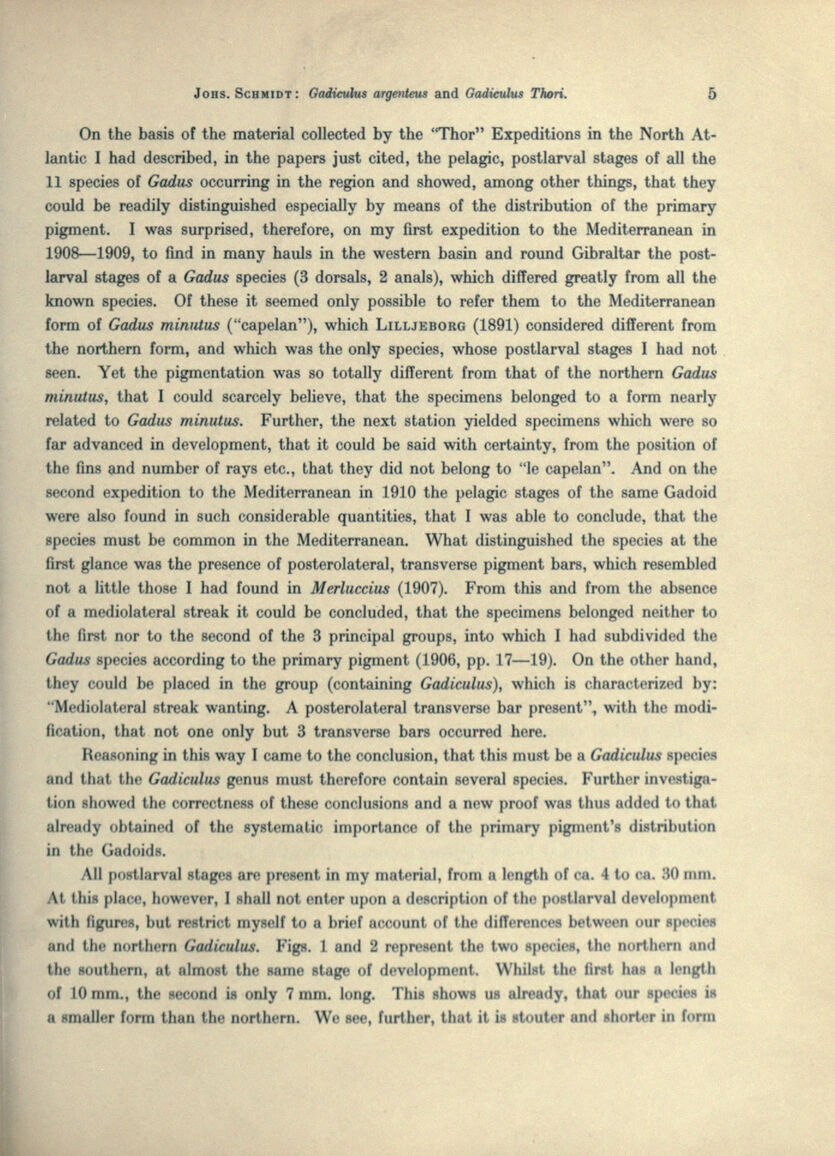
Full resolution (JPEG) - On this page / på denna sida - Gadiculus Argenteus and Gadiculus Thori

<< prev. page << föreg. sida << >> nästa sida >> next page >>
Below is the raw OCR text
from the above scanned image.
Do you see an error? Proofread the page now!
Här nedan syns maskintolkade texten från faksimilbilden ovan.
Ser du något fel? Korrekturläs sidan nu!
This page has been proofread at least once.
(diff)
(history)
Denna sida har korrekturlästs minst en gång.
(skillnad)
(historik)
On the basis of the material collected by the “Thor” Expeditions in the North
Atlantic I had described, in the papers just cited, the pelagic, postlarval stages of all the
11 species of Gadus occurring in the region and showed, among other things, that they
could be readily distinguished especially by means of the distribution of the primary
pigment. I was surprised, therefore, on my first expedition to the Mediterranean in
1908—1909, to find in many hauls in the western basin and round Gibraltar the
postlarval stages of a Gadus species (3 dorsals, 2 anals), which differed greatly from all the
known species. Of these it seemed only possible to refer them to the Mediterranean
form of Gadus minutus (“capelan”), which Lilljeborg (1891) considered different from
the northern form, and which was the only species, whose postlarval stages I had not
seen. Yet the pigmentation was so totally different from that of the northern Gadus
minutus, that I could scarcely believe, that the specimens belonged to a form nearly
related to Gadus minutus. Further, the next station yielded specimens which were so
far advanced in development, that it could be said with certainty, from the position of
the fins and number of rays etc., that they did not belong to “le capelan”. And on the
second expedition to the Mediterranean in 1910 the pelagic stages of the same Gadoid
were also found in such considerable quantities, that I was able to conclude, that the
species must be common in the Mediterranean. What distinguished the species at the
first glance was the presence of posterolateral, transverse pigment bars, which resembled
not a little those I had found in Merluccius (1907). From this and from the absence
of a mediolateral streak it could be concluded, that the specimens belonged neither to
the first nor to the second of the 3 principal groups, into which I had subdivided the
Gadus species according to the primary pigment (1906, pp. 17—19). On the other hand,
they could be placed in the group (containing Gadiculus), which is characterized by:
“Mediolateral streak wanting. A posterolateral transverse bar present”, with the
modification, that not one only but 3 transverse bars occurred here.
Reasoning in this way I came to the conclusion, that this must be a Gadiculus species
and that the Gadiculus genus must therefore contain several species. Further
investigation showed the correctness of these conclusions and a new proof was thus added to that
already obtained of the systematic importance of the primary pigment’s distribution
in the Gadoids.
All postlarval stages are present in my material, from a length of ca. I 4 to ca. 30 mm.
At this place, however, I shall not enter upon a description of the postlarval development
with figures, but restrict myself to a brief account of the differences between our species
ami the northern Gadiculus. Figs. 1 and 2 represent the two species, the northern and
the southern, at almost the same stage of development. Whilst the first has a length
of 10 mm., the second is only 7 mm. long. This shows us already, that our species is
a smaller form than the northern. We see, further, that it is stouter and shorter in form
<< prev. page << föreg. sida << >> nästa sida >> next page >>